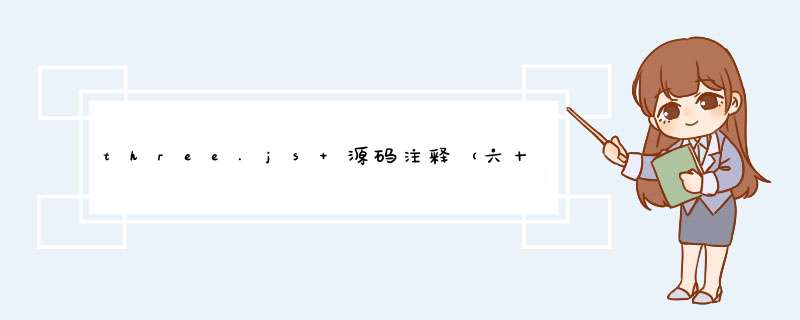
俺也是刚开始学,好多地儿肯定不对还请见谅.
以下代码是THREE.Js 源码文件中objects/PointCloud.Js文件的注释.
更多更新在 : https://github.com/omni360/three.Js.sourcecode
/** * @author alteredq / http://alteredqualia.com/ *//*///PointCloud点云对象,在场景中方便的改变大量的点精灵对象大小,位置等属性.*////PointCloud///Geometry对象点云对象里的点集合///PointCloudMaterial对象(点云材质对象)///返回Mesh对象THREE.PointCloud = function ( geometry,material ) { THREE.Object3D.call( this ); //调用Object3D对象的call方法,将本来属于Object3D的方法交给当前对象PointCloud来使用. this.geometry = geometry !== undefined ? geometry : new THREE.Geometry(); // //将参数geometry赋值给mesh对象的geometry属性 this.material = material !== undefined ? material : new THREE.PointCloudMaterial( { color: Math.random() * 0xffffff } ); //将参数material赋值给PointCloud对象的material属性,如果没有传递material参数,将创建随机色彩材质,赋值给当前PointCloud对象 this.sortParticles = false; //设置是不是排序粒子?? //Todo:sortParticles属性没有弄明白,有时间回来处理.};/*****************************************************下面是PointCloud对象的方法属性定义,继承自Object3D**************************************************/THREE.PointCloud.prototype = Object.create( THREE.Object3D.prototype );/*///raycast方法用来取得当前对象与射线(参数raycaster)的交点.raycaster.intersectObject会调用这个方法。主要是用来进行碰撞检测,/// 在选择场景中的对象时常常会用到,判断当前鼠标是不是与对象重适用来选择对象./// NOTE:raycast方法中参数intersects参数用来存储交点的集合,格式以下/// intersects.push( {////// distance: distance,/// point: intersectionPoint,/// indices: [ a,b,c ],/// face: null,/// faceIndex: null,/// object: this////// } );///*////raycast///射线对象///交点的属性集合///交点的属性集合THREE.PointCloud.prototype.raycast = ( function () { var inverseMatrix = new THREE.Matrix4(); //声明1个4x4矩阵,用来放置逆矩阵 var ray = new THREE.Ray(); //声明全局射线对象 return function ( raycaster,intersects ) { var object = this; var geometry = object.geometry; var threshold = raycaster.params.PointCloud.threshold; inverseMatrix.getInverse( this.matrixWorld ); ray.copy( raycaster.ray ).applyMatrix4( inverseMatrix ); if ( geometry.boundingBox !== null ) { if ( ray.isIntersectionBox( geometry.boundingBox ) === false ) { return; } } var localThreshold = threshold / ( ( this.scale.x + this.scale.y + this.scale.z ) / 3 ); var position = new THREE.Vector3(); //检查射线与点云元素是不是碰撞的具体实现. var testPoint = function ( point,index ) { var rayPointdistance = ray.distancetoPoint( point ); if ( rayPointdistance < localThreshold ) { var intersectPoint = ray.closestPointtopoint( point ); intersectPoint.applyMatrix4( object.matrixWorld ); var distance = raycaster.ray.origin.distanceto( intersectPoint ); intersects.push( { distance: distance,distancetoRay: rayPointdistance,point: intersectPoint.clone(),index: index,face: null,object: object } ); } }; //如果geometry对象是BufferGeometry对象 if ( geometry instanceof THREE.BufferGeometry ) { var attributes = geometry.attributes; var positions = attributes.position.array; //下面对3种数据格式的pointCloud对象的元素进行检测. if ( attributes.index !== undefined ) { var indices = attributes.index.array; var offsets = geometry.offsets; if ( offsets.length === 0 ) { var offset = { start: 0,count: indices.length,index: 0 }; offsets = [ offset ]; } for ( var oi = 0,ol = offsets.length; oi < ol; ++oi ) { var start = offsets[ oi ].start; var count = offsets[ oi ].count; var index = offsets[ oi ].index; for ( var i = start,il = start + count; i < il; i ++ ) { var a = index + indices[ i ]; position.set( positions[ a * 3 ],positions[ a * 3 + 1 ],positions[ a * 3 + 2 ] ); testPoint( position,a ); } } } else { var pointCount = positions.length / 3; for ( var i = 0; i < pointCount; i ++ ) { position.set( positions[ 3 * i ],positions[ 3 * i + 1 ],positions[ 3 * i + 2 ] ); testPoint( position,i ); } } } else { var vertices = this.geometry.vertices; for ( var i = 0; i < vertices.length; i ++ ) { testPoint( vertices[ i ],i ); } } }; }() ); /*clone方法 ///clone方法克隆1个PointCloud点云对象. */ ///clone///接收克隆的Object3D对象///返回PointCloud对象.THREE.PointCloud.prototype.clone = function ( object ) { if ( object === undefined ) object = new THREE.PointCloud( this.geometry,this.material ); object.sortParticles = this.sortParticles; THREE.Object3D.prototype.clone.call( this,object ); //继承Object3D的clone方法 return object; //返回克隆的PointCloud对象};// Backwards compatibility 向后兼容,粒子系统呗点云对象替换.用法和THREE.PointCloud对象1样.THREE.ParticleSystem = function ( geometry,material ) { console.warn( 'THREE.ParticleSystem has been renamed to THREE.PointCloud.' ); return new THREE.PointCloud( geometry,material );};
商域无疆 (http://blog.csdn.net/omni360/)
本文遵守“署名-非商业用处-保持1致”创作公用协议
转载请保存此句:商域无疆 - 本博客专注于 敏捷开发及移动和物联装备研究:数据可视化、GolANG、HTML5、WEBGL、THREE.Js,否则,出自本博客的文章谢绝转载或再转载,谢谢合作。
以下代码是THREE.Js 源码文件中objects/PointCloud.Js文件的注释.
更多更新在 : https://github.com/omni360/three.Js.sourcecode
总结以上是内存溢出为你收集整理的three.js 源码注释(六十七)objects/PointCloud.js全部内容,希望文章能够帮你解决three.js 源码注释(六十七)objects/PointCloud.js所遇到的程序开发问题。
如果觉得内存溢出网站内容还不错,欢迎将内存溢出网站推荐给程序员好友。
欢迎分享,转载请注明来源:内存溢出

 微信扫一扫
微信扫一扫
 支付宝扫一扫
支付宝扫一扫
评论列表(0条)